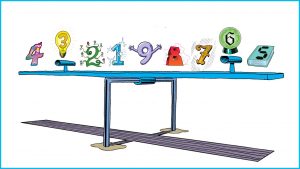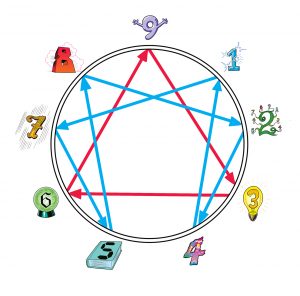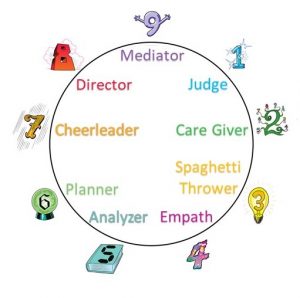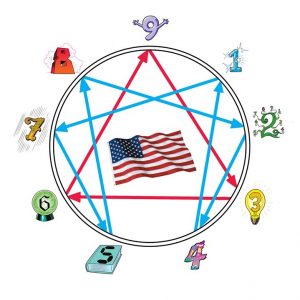
Where does creativity come from? Can anyone be creative? How can you tap into your own personal creativity?
I know a very smart, creative person who confided in me that they do not think that they are creative. WHAT? I couldn’t believe my ears. I wondered if this person had defined creativity so narrowly that they discounted and minimized certain forms of creativity, including their own. Based on their self-perception, I am afraid the answer to that is yes.
In my book Teamwork 9.0, I explore the application of the Enneagram to team problem solving. The Enneagram is commonly used as a powerful personality system, but it can be used more broadly than that. Most people who use the Enneagram for personality are unaware that the reason the Enneagram types are numbers is that the numbers represent the order in which people solve problems. In short, the Enneagram is also a problem-solving process represented by motion around the circle, from steps 1 to 9 and back to 1.

As a problem-solving framework, the Enneagram provides a direct link between a step in problem solving and a personality dynamic that is perfectly suited for that step—step 1 connects to Type 1, step 2 to Type 2, etc. It goes to reason that each step in problem solving requires a certain creative dynamic, implying that there may be nine distinct creative energies, each suited for a particular step in the process.
Necessity the Mother of Invention?
In Chapter 5 of Teamwork 9.0, I describe nine distinct creative dynamics, one for each Enneagram type. Inspired by the saying, “Necessity is the Mother of Invention,” I thought about how “necessity” affects each type. Looking at the Enneagram diagram, each Enneagram type is connected to two other types by what are called the Path of Integration (direction of arrow) and Path of Disintegration (opposite of arrow). These paths describe how the behaviors of each type change when we move into a stressful situation (Path of Disintegration) or into a stress-free situation (Path of Integration.) The movement between stressful and stress-free, can serve as an engine of creativity for each type. I characterize this dynamic like the motion of a seesaw. Imagine the following:
Stressful See: Posed with a problem or challenge, a need arises that you must address.
Stress-free Saw: You sleep on the problem and, in your calm state, generate a possible solution which occurs to you when you awake or when you are in the shower the next morning.
Stressful See: Now you need to implement the proposal by acting on your idea.
Stress-free Saw: You are relieved that you are making progress, moving towards resolving the problem.
Stressful See: You encounter an obstacle preventing you from reaching your goal and requiring that you take a new direction.
Stress-free Saw: You sleep on the new problem, and so on.
Each Enneagram type will respond distinctly to the Stressful-Stress-free dynamic, each with a distinct creative flare. The Enneagram provides an understanding of each creative energy. It shows how each creativity contributes to problem solving. Knowing that each Enneagram type brings a unique creative contribution reminds us of the value and benefit of having style-diversity on your teams.
Creativity Seesaw: Inspiration-Action
Thomas Edison famously said, “Genius is 1 percent inspiration and 99 percent perspiration.” Indeed, for each Enneagram type, one path leads more to inspiration, and the other towards action. The seesaw is a metaphor for moving back and forth between inspiration and action during the creative process. And while the inspiration-action ratio for Edison may have been 1-to-99, that ratio may be different for each Enneagram type (I’ll hazard a guess that Edison was a Type 3.)
Here are the nine Inspiration-Action pairs as prescribed by movement along the Enneagram paths:
| Enneagram Type 1 Creativity | Inspiration — Identifying what’s missing to make things right
Action — Informing others to right wrongs |
| Enneagram Type 2 Creativity | Inspiration — Feeling how they can help
Action — Acting on those feelings |
| Enneagram Type 3 Creativity | Inspiration — Seeking to appease others
Action — Systematically achieving goals |
| Enneagram Type 4 Creativity | Inspiration — Intense feelings for what is missing
Action — Self-righteous express of that void |
| Enneagram Type 5 Creativity | Inspiration — Assimilating information
Action — Asserting knowledge |
| Enneagram Type 6 Creativity | Inspiration — Envisioning systems that work for everyone
Action — Anxiously working through their to-do list |
| Enneagram Type 7 Creativity | Inspiration — Collecting and synthesizing ideas
Action — Dogmatically promoting their ideas |
| Enneagram Type 8 Creativity | Inspiration — Scanning for opportunities while restrained from acting
Action — Acting to help themselves and others |
| Enneagram Type 9 Creativity | Inspiration — Understanding the cause and nature of discord
Action — Actively creating harmonious environments |
Motivation is the Seesaw Fulcrum
Underpinning the creativity seesaw for each Enneagram type is the distinct motivation associated with that type. This motivation underlies our inclinations toward inspiration and action as we move back and forth on our paths. And like the height of the fulcrum of the seesaw, the higher our motivation, the more motion we will get back and forth between inspiration and action. I review the nine underlying motivations of each Enneagram type in this YouTube video:
Mother Necessity or Father Time?
Calling “necessity” the mother, does imply that there is a father. While I do not think either necessity nor creativity is gendered, I do think that there is a duality to creativity and that the duality can be understood by the inspiration-action pairs. Also, if you look closely at each pair, you will see that some types receive inspiration along the path of disintegration while others receive inspiration in integration. This has implications for team effectiveness. Sometimes in problem solving inspiration comes when team members are under stress. Sometimes inspiration comes when stress-free. This dynamic is also true for certain Enneagram personality types. Team leaders can use this information to achieve the best outcomes for their teams.
Creativity Broadly
Before, I would have never considered myself a “creative type,” at least as I had understood the term. I associated the “creative type” with what I now understand to be the Enneagram Type 4 dynamic, the type often called “the “Artist.” Now I understand that my previous definition of creative type is very narrow and that each of us has a creative engine within us that fires up as the need arises. We may not even be aware of our creative abilities if we are not put into situations that trigger those creative instincts. Knowing your Enneagram type can help you tap into and maximize you own personal creativity.
Want More?
For more details on each Enneagram type’s creative style, see the following series of blogs:
Enneagram Type 2 Creativity – Create with the heart; build with the mind. – Criss Jami
Enneagram Type 4 Creativity – Everything you can imagine is real. – Pablo Picasso
Enneagram Type 6 Creativity – The creative adult is the child who survived. – Ursula Kroeber Le Guin
How do you characterize your creativity? What’s your source for ideas? What motivates you to action. How does creativity play a role in your day-to-day life?




